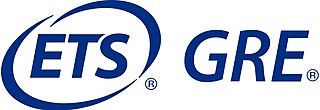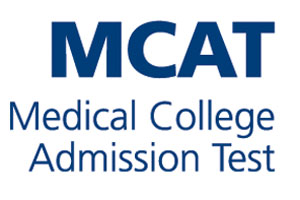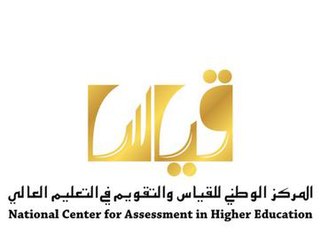
The Graduate Management Admission Test is a computer adaptive test (CAT) intended to assess certain analytical, writing, quantitative, verbal, and reading skills in written English for use in admission to a graduate management program, such as a Master of Business Administration (MBA) program. Answering the test questions requires knowledge of English grammatical rules, reading comprehension, and mathematical skills such as arithmetic, algebra, and geometry. The Graduate Management Admission Council (GMAC) owns and operates the test, and states that the GMAT assesses analytical writing and problem-solving abilities while also addressing data sufficiency, logic, and critical reasoning skills that it believes to be vital to real-world business and management success. It can be taken up to five times a year but no more than eight times total. Attempts must be at least 16 days apart.

The Graduate Record Examinations (GRE) is a standardized test that is part of the admissions process for many graduate schools in the United States and Canada and a few other countries. The GRE is owned and administered by Educational Testing Service (ETS). The test was established in 1936 by the Carnegie Foundation for the Advancement of Teaching.

The Law School Admission Test is a standardized test administered by the Law School Admission Council (LSAC) for prospective law school candidates. It is designed to assess reading comprehension, analytical reasoning, and logical reasoning. The test is an integral part of the law school admission process in the United States, Canada, the University of Melbourne, Australia, and a growing number of other countries.
The Swedish Scholastic Aptitude Test (SweSAT)(Swedish: högskoleprovet) is a standardised test used as one of the means to gain admission to higher education in Sweden. The test itself, which is administered by the Swedish Council for Higher Education, is divided into a mathematical part and a verbal part, which both respectively contain 4 subdivisions, in total 160 multiple-choice questions. All sections are taken in one day, a Saturday in April or a Sunday in October, lasting between 7½ and 8 hours including breaks between each section and a lunch break. Apart from the English language reading comprehension test, all sections are taken in Swedish.
Joint Management Entrance Test (JMET) was an admission exam used by some institutes in India as the first step in the admission to postgraduate programs in management. Institutes which used the exams included Indian Institute of Science (IISc) and the IIT Schools of Management. The results of JMET were used to short-list the candidates for subsequent part of the selection process. In 2011 JMET was discontinued and replaced by Common Admission Test (CAT).
The Independent School Entrance Examination (ISEE) is an entrance exam used by many independent schools and magnet schools in the United States. Developed and administered by the Educational Records Bureau (ERB), the ISEE has four levels: the Primary level, for entrance to grades 2–4; Lower level, for entrance in grades 5–6; Middle level, for entrance in grades 7–8; Upper level, for entrance in grades 9–12. All levels consist of five sections: Verbal Reasoning, Quantitative Reasoning, Reading Comprehension, Mathematics Achievement, and a 30-minute essay. The ISEE can be seen as a parallel to the Secondary School Admission Test, or SSAT. It is currently administered by Measurement Incorporated.
The Graduate Aptitude Test in Engineering (GATE) is an entrance examination conducted in India that primarily tests the comprehensive understanding of undergraduate subjects in engineering and sciences for admission into postgraduate programs. GATE is conducted jointly by the Indian Institute of Science and seven Indian Institutes of Technologies at Roorkee, Delhi, Guwahati, Kanpur, Kharagpur, Chennai (Madras) and Mumbai (Bombay) on behalf of the National Coordination Board – GATE, Department of Higher Education, Ministry of Education (MoE), Government of India.
Verbal reasoning is understanding and reasoning using concepts framed in words. It aims at evaluating ability to think constructively, rather than at simple fluency or vocabulary recognition.
The Secondary School Admission Test (SSAT) is an admission test administered by The Enrollment Management Association in the United States to students in grades 3–11 to provide a standardized measure that will help professionals in independent or private elementary, middle, and high schools to make decisions regarding student test taking.
The Dental Admission Test is a multiple-choice standardized exam taken by potential dental school students in the United States and Canada. The DAT is a computer based test that can be administered almost any day of the year. Tests are taken at Prometric testing centers throughout the United States after the preliminary application through the American Dental Association is completed. Each applicant may only take the test a total of three times before having to ask special permission to take the exam again. After taking the exam, applicants must wait 90 days before repeating it. Each exam costs $525, all of which is non-refundable.
The University Clinical Aptitude Test (UCAT) is an admissions test used in the selection process by a consortium of universities in the United Kingdom, Singapore, Australia and New Zealand for their medical and dental degree programmes. UCAT is needed, except very few universities, for admission into undergraduate medical degrees in Australia, New Zealand, Singapore, and UK. Launched in 2006 as the UK Clinical Aptitude Test (UKCAT), it was renamed in 2019 following the launch of the test in Australia and New Zealand.
The Psychometric Entrance Test (PET) – commonly known in Hebrew as "ha-Psikhometri" – is a standardized test that serves as an entrance exam for institutions of higher education in Israel. The PET covers three areas: quantitative reasoning, verbal reasoning and English language. It is administered by the National Institute for Testing and Evaluation (NITE) and plays a considerable role in the admissions process. A score combining students' performance on the PET with the average score of their high school matriculation tests has been found to be a highly predictive indicator of students' academic performance in their first year of higher education.
Gujarat Common Entrance Test (GCET) is an annual common entrance exam for MBA and MCA studies in Gujarat, India, since 2002. Every year it is conducted between March and August. Gujarat Technological University was inaugurated in October 2007. Then, it started conducting GCET.
The Optometry Admission Test (OAT) is a test used to determine applicants' qualification for admission to a school of optometry. All colleges of optometry in the United States and the University of Waterloo in Canada use scores from the exam, in addition to work done at the undergraduate level of study, to decide whether to accept candidates. The test is administered by the American Dental Association (ADA) on behalf of the Association of Schools and Colleges of Optometry (ASCO).

The Medical College Admission Test is a computer-based standardized examination for prospective medical students in the United States, Australia, Canada, and the Caribbean Islands. It is designed to assess problem solving, critical thinking, written analysis and knowledge of scientific concepts and principles. Before 2007, the exam was a paper-and-pencil test; since 2007, all administrations of the exam have been computer-based.
Common Management Admission Test (CMAT) is an online computer-based test conducted by the National Testing Agency (NTA), India. It is a national-level admission test for facilitating institutions to select suitable students for admission in all management programmes approved by AICTE.
To face the shortage of Indian Police Service officers in India as a result the high attrition in the Indian Police Service, the Ministry of Home Affairs proposed the formation of Indian Police Service Limited Competitive Examination to be conducted by UPSC. IPS Limited Competitive Examination was held for the first time in 2012. This is in addition to the Civil Services Examination conducted by UPSC itself, for recruitment to the various civil services including Indian Police Service.The Central Administrative Tribunal (CAT) has struck down the examination following the challenge by some state cadre police officers. Consequent to the CAT verdict, UPSC has withheld the declaration of final results of 2012 examination. Now, the Ministry of Home Affairs is trying to sort out the legal matters as soon as possible.

Measurement is derived from the verb 'to measure' which means to assess something; in Arabic 'yaqees' 'measure' has the meaning of comparing something to something else. In this sense, measurement is a daily practice that manifests itself in all our assessment activities, whether we assess concrete things in terms of size and color, or abstract things such as human relations. The ultimate goal of 'measuring' something is to assess ourselves in comparison to everything else in the world.
The Policy Aptitude Test (PAT) is an offline written test held in India. This test scores a person on the bases of General Knowledge, Numerical Problem Solving, Policy Aptitude, Logical Reasoning, English Language and Policy Analysis Ability. The National Law School of India University, Bengaluru (NLSIU) started this exam and use the test for selecting students for its Public Policy Programme. The test is conducted every year.
Qiyas Tests is a set of college admission tests in Saudi universities belonging to the Education & Training Evaluation Commission (ETEC).




